Hoover DXC4E47B3, DXC4E47W3, DXCC48W3, DXCC49B3, DXCC49W3 User Manual
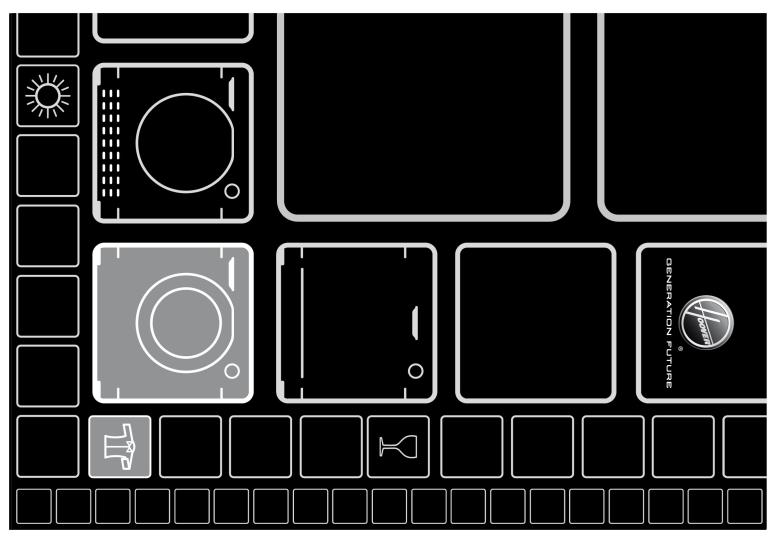
EN

Thank-you for choosing a Hoover washing machine. We are proud to always offer new, innovative and technologically advanced products, with a complete range of home appliances to ensure true assistance in your daily routine.
We suggest you register your product at www.registerhoover.com to gain faster access to supplementary services solely reserved to our most loyal customers.
Carefully read this manual for correct and safe appliance use and for helpful tips on efficient maintenance.
Environmental conditions
This appliance is marked according to the European directive 2012/19/EU on Waste Electrical and Electronic Equipment (WEEE).
WEEE contains both polluting substances (which can cause negative consequences for the environment) and basic components (which can be re-used). It is important to have WEEE subjected to specific treatments, in order to remove and dispose properly all pollutants, and recover and recycle all materials. Individuals can play an important role in ensuring that WEEE does not become an environmental issue; it is essential to follow some basic rules:
 Only use the washing machine after carefully reading these instructions. We recommend you always keep this manual on hand and in good conditions for any future owners.
Only use the washing machine after carefully reading these instructions. We recommend you always keep this manual on hand and in good conditions for any future owners.
Please check that the appliance is delivered with this instruction manual, warranty certificate, service centre address and energy efficiency label. Also check that plugs, curve for drain hose and liquid detergent or bleach tray (only on some models) are included. We recommend you keep all these components.
Each product is identified by a unique 16character code, also called the “serial number”, printed on the sticker affixed to the appliance (porthole area) or in the document envelope found inside the product. This code is a sort of specific product ID card that you will need to register it and should you need to contact the Hoover Customer Service Centre.
!WEEE should not be treated as household waste;
!WEEE should be handed over to the relevant collection points managed by the municipality or by registered companies. In many countries, for large WEEE, home collection could be present.
In many countries, when you buy a new appliance, the old one may be returned to the retailer who has to collect it free of charge on a one-to-one basis, as long as the equipment is of equivalent type and has the same functions as the supplied equipment.
Contents
1.GENERAL SAFETY RULES
2.INSTALLATION
3.PRACTICAL TIPS
4.MAINTENANCE AND CLEANING
5.QUICK USER GUIDE
6.CONTROLS AND PROGRAMS
7.CUSTOMER SERVICE CENTRE AND WARRANTY
2
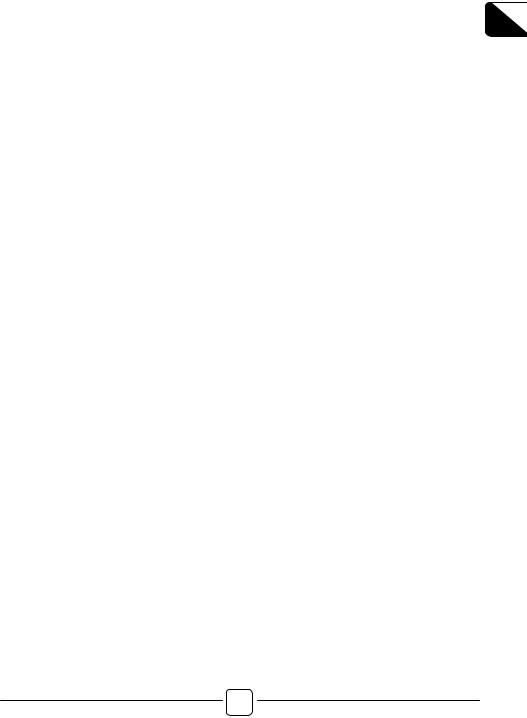
1.GENERAL SAFETY RULES
!This appliances is intended to be used in household and similar applications such as:
-Staff kitchen areas in shops, offices and other working environments;
-Farm houses;
-By clients in hotels, motels and other residential type environments;
-Bed and breakfast type environments. A different use of this appliance from household environment or from typical housekeeping functions, as commercial use by expert or trained users, is excluded even in the above applications. If the appliance is used in a manner inconsistent with this it may reduce the life of the appliance and may void the manufacturer’s warranty. Any damage to the appliance or other damage or loss arising through use that is not consistent with domestic or household use (even if located in a domestic or household environment) shall not be accepted by the manufacturer to the fullest extent permitted by law.
!This appliance can be used by children aged from 8 years and above and persons with reduced physical, sensory or mental capabilities or lack of experience and knowledge if they have been given supervision or instruction concerning use of the appliance in a safe way and understand the hazards involved.
Children shall not play with the appliance. Cleaning and user maintenance shall not be made by children without supervision.
!Children should be supervised to ensure that they do not play with the appliance.
!Children of less than 3 years should be kept away unless continuously supervised.
!If the supply cord is damaged, it must be replaced by the manufacturer, its service agent or similarly qualified persons in order to avoid a hazard.
!Only use the hose-sets supplied with the appliance for the water supply connection (do not reuse old hose-sets).
!Water pressure must be between 0,05 MPa and 0,8 MPa.
!Make sure that a carpet do not obstruct the base of the machine and ventilation openings.
!The OFF condition is reached by placing the reference mark on the programmes control/knob in the vertical position. Any other different position of such control sets the machine in ON condition (only for models with programmes knob).
!After installation, the appliance must be positioned so that the plug is accessible.
!The maximum load capacity of dry clothes depends on the model used (see control panel).
EN
3
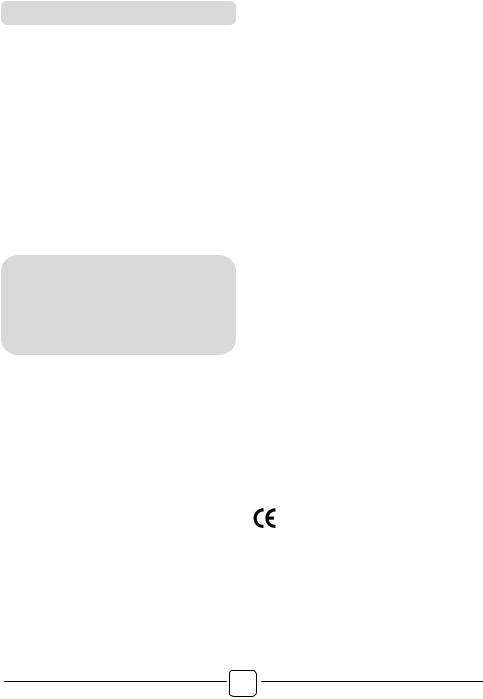
!To consult the product fiche please refer to the manufacturer website.
Safety instructions
!Before cleaning or maintaining the washing machine, unplug the appliance and turn off the water faucet.
!Make sure the electrical system is grounded. Otherwise, seek qualified professional assistance.
!In the event of fault and/or malfunction, turn off the washing machine, close the water faucet and do not tamper with the appliance.
Immediately contact the Customer Service Centre and only use original spare parts. Failure to observe these instruction may jeopardise appliance safety.
!Please do not use converters, multiple sockets or extension cords.
 WARNING:
WARNING:
water may reach very high temperatures during the wash cycle.
!Make sure there is no water in the drum before opening the porthole.
!Do not pull on the power cord or appliance to unplug the machine.
!Do not expose the washing machine to rain, direct sunlight or other weather elements.
!When moving, do not lift the washing machine by the knobs or detergent drawer; during transport, never rest the porthole on the trolley. We recommend two people lift the washing machine.
4
Appliance complies with European Directives:
!2006/95/EC (LVD);
!2004/108/EC (EMC);
!2009/125/EC (ErP);
!2011/65/EU (RoHS)
and subsequent amendments.
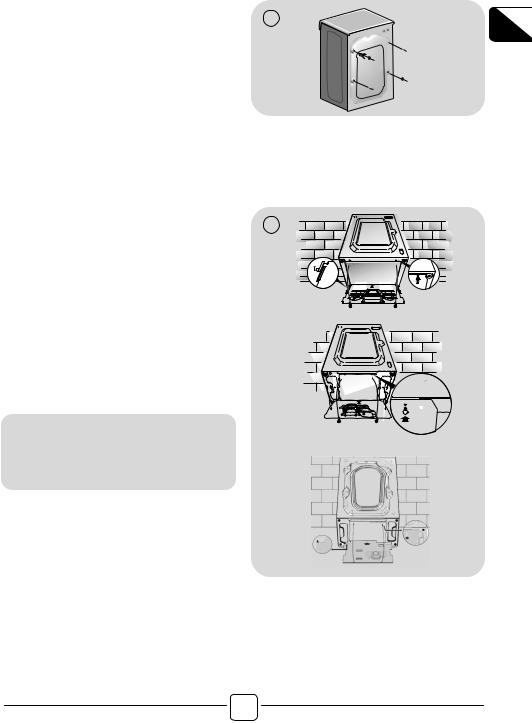
2. INSTALLATION
!Cut the tube straps, being careful not to damage the tube and power cord.
!Unscrew the 2 or 4 screws (A) on the back and remove the 2 or 4 shims (B) as illustrated in figure 1.
!Close the 2 or 4 holes using the plugs included in the instruction envelope.
!If the washing machine is built-in, after cutting the hose straps, unscrew the 3 or 4 screws (A) and remove the 3 or 4 shims (B).
!In some models, 1 or more shims will fall inside the machine: tilt the washing machine forward to remove them. Close the holes using the plugs found in the envelope.
 WARNING:
WARNING:
keep packaging materials away from children.
!Place the polionda sheet on the bottom as shown in figure 2 (according to the model, consider version A, B or C).
5
1
A 
 A
A
BA B A
B B
B
2
A |
|
3 |
|
1 |
2 |
||
|
B
C
3
2 |
1 |
EN
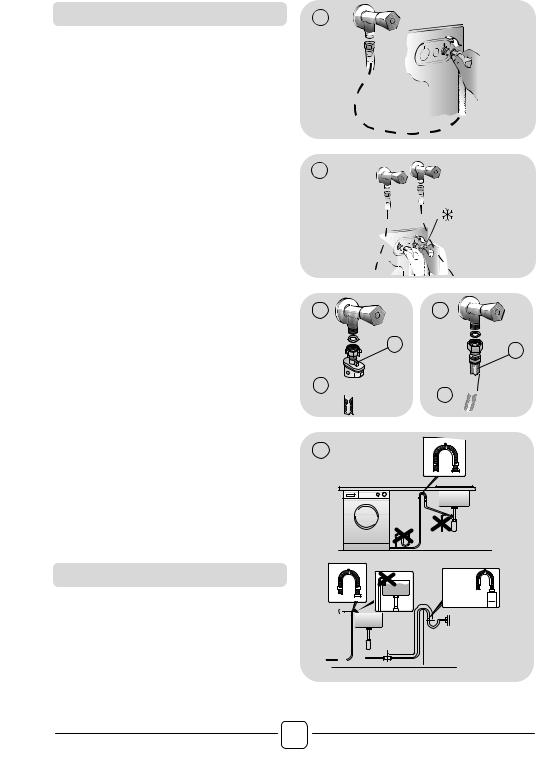
Hydraulic connections
!Connect the water tube to the faucet, only using the drain tube supplied with the washing machine (fig. 3).
DO NOT OPEN THE FAUCET.
!Some models may include one or more of the following features:
!HOT&COLD (fig. 4):
water mains connection settings with hot and cold water for higher energy savings.
Connect the grey tube to the cold water faucet  and the red one to the hot water faucet. The machine can be connected to the cold water faucet only: in this case, some programs may start a few minutes later.
and the red one to the hot water faucet. The machine can be connected to the cold water faucet only: in this case, some programs may start a few minutes later.
!AQUASTOP (fig. 5):
a device located on the supply tube that stops water flow if the tube deteriorates; in this case, a red mark will appear in the window “A” and the tube must be replaced. To unscrew the nut, press the one-way lock device "B".
!AQUAPROTECT – SUPPLY TUBE WITH GUARD (fig. 6):
Should water leak from the primary internal tube "A", the transparent containment sheath "B" will contain water to permit the washing cycle to complete. At the end of the cycle, contact the Customer Service Centre to replace the supply tube.
1
5 |
6 |
B |
B |
|
A 

 A
A 

7
Setting
!Near the washing machine to the wall, being careful that the tube is not bent or crushed, and place the drain tube in the tub or, preferably, connect it to a wall drain at least 50 cm high with diameter greater than the washing machine tube
(fig. 7).
6
max 100 cm
|
min 4 cm |
+2,6 mt |
|
max |
min 50 cm |
|
max 85 cm |
